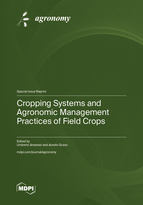Cropping Systems and Agronomic Management Practices of Field Crops
A special issue of Agronomy (ISSN 2073-4395). This special issue belongs to the section "Innovative Cropping Systems".
Deadline for manuscript submissions: closed (15 May 2023) | Viewed by 105535
Special Issue Editors
Interests: agronomy; cropping systems; oilseed crops; legume crops; cereal crops field crops; cover crops; agrobiodiversity; ecophysiology, abiotic stress; product quality
Special Issues, Collections and Topics in MDPI journals
Interests: agronomy; crop production; allelopathy; weed science; weed management; cover crops; fertilization; Cynara cardunculus; potato
Special Issues, Collections and Topics in MDPI journals
Special Issue Information
Dear Colleagues,
Agriculture is facing the challenge of the transition to sustainability to meet the growing demand for food, feed, and for several other renewable nonfood raw materials under a changing climatic scenario. Understanding the complexity of the agroecosystems can favor research on innovative agronomic practices to guide this change. The optimization of the spatiotemporal combination among plants in farming systems (crop sequence and intercropping), the exploitation of the different forms of biodiversity at soil and plant level, the increase in the use efficiency of native resources (radiation and rainfall, N2, CO2, H2O, etc.) and the reduction of the dependence on external energy input (soil tillage, agrochemicals and mineral fertilizers) represent the driving force behind this paradigmatic change. This approach will ensure the enhancement of the territorial vocation in productive and qualitative terms, also promoting several ecosystem services, from carbon sequestration to landscape ecology.
The scientific community is called to take up this challenge, which can contribute to the progress of agriculture while safeguarding the biosphere. For these reasons, the present Special Issue will focus on recent advancements in the wide scientific area of field crops in order to identify strategies and tactics calibrated site-by-site for an eco-friendly and efficient agronomic management. We encourage, in particular, contributions on the choice of plant species and cultivars (traditional and improved) and agronomic practices (soil tillage, fertilization, irrigation, weed control) to design and manage productive and sustainable cropping systems with different degrees of intensification and scale, from traditional to commercial farming (smallholding, organic, protected areas; mixed, pastoral, hay, site-specific), variously spread throughout the world. The influence of these agronomic aspects on the quality of the products of field crops will also be considered. Research papers, communications, and review articles on the abovementioned topics are welcome.
Dr. Umberto Anastasi
Dr. Aurelio Scavo
Guest Editors
Manuscript Submission Information
Manuscripts should be submitted online at www.mdpi.com by registering and logging in to this website. Once you are registered, click here to go to the submission form. Manuscripts can be submitted until the deadline. All submissions that pass pre-check are peer-reviewed. Accepted papers will be published continuously in the journal (as soon as accepted) and will be listed together on the special issue website. Research articles, review articles as well as short communications are invited. For planned papers, a title and short abstract (about 100 words) can be sent to the Editorial Office for announcement on this website.
Submitted manuscripts should not have been published previously, nor be under consideration for publication elsewhere (except conference proceedings papers). All manuscripts are thoroughly refereed through a single-blind peer-review process. A guide for authors and other relevant information for submission of manuscripts is available on the Instructions for Authors page. Agronomy is an international peer-reviewed open access monthly journal published by MDPI.
Please visit the Instructions for Authors page before submitting a manuscript. The Article Processing Charge (APC) for publication in this open access journal is 2600 CHF (Swiss Francs). Submitted papers should be well formatted and use good English. Authors may use MDPI's English editing service prior to publication or during author revisions.
Keywords
- agronomy
- field crops
- agrobiodiversity
- fertilization
- irrigation
- weed management
- soil management
- crop quality
- cover cropping
- crop physiology
- organic farming
- climatic change
- sustainability
- ecosystem services







